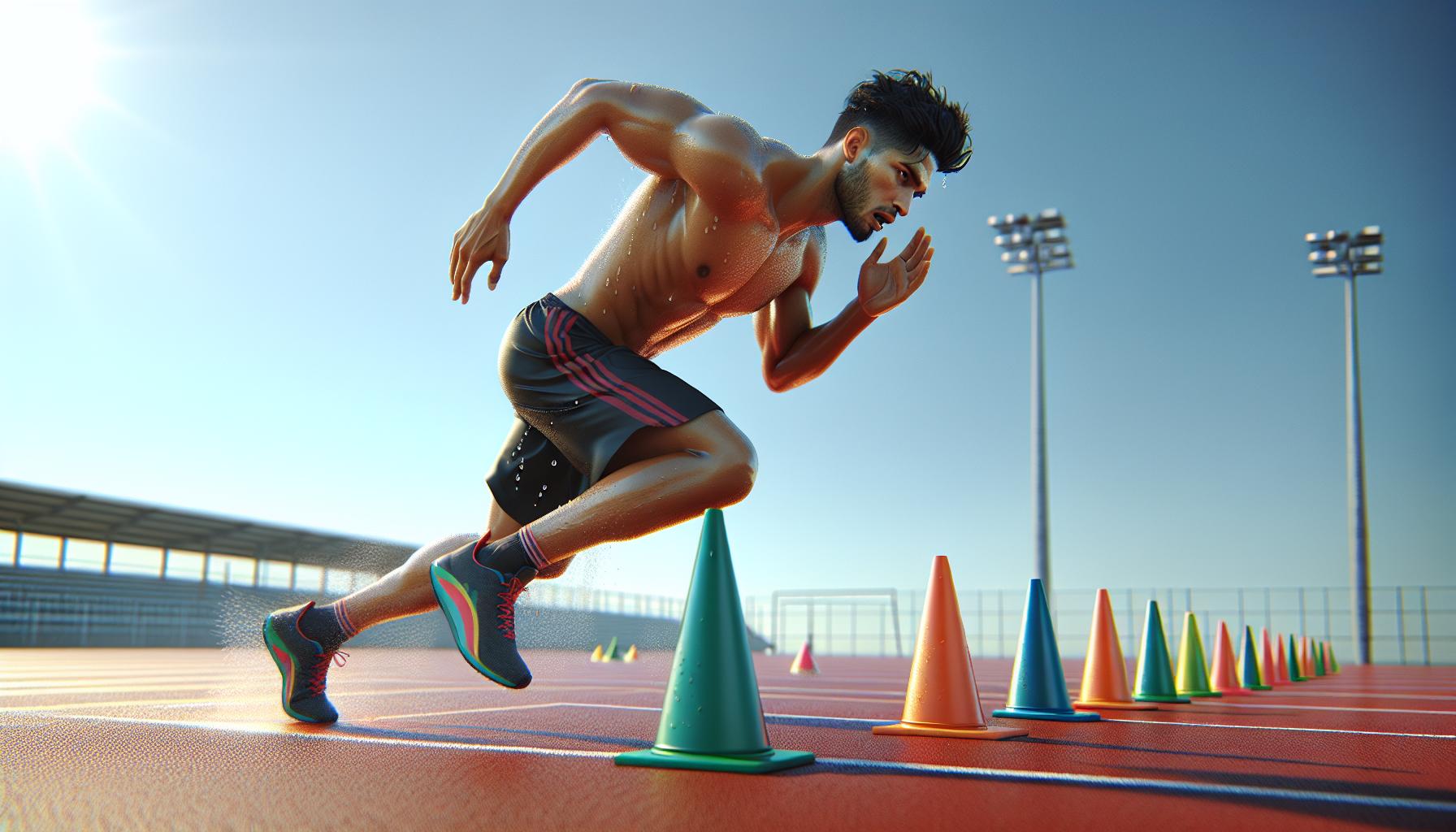When you set out on your fitness journey, you’re often bombarded with goals and terms that might seem interchangeable at first glance. But dig a little deeper, and you’ll find that skill-related fitness goals and health-related fitness goals are fundamentally different beasts. Understanding this distinction is crucial for tailoring your workout plan to your personal aspirations.
Skill-related fitness zeroes in on improving your performance in physical activities, think agility, balance, coordination, speed, power, and reaction time. It’s about honing those abilities that make you more adept at sports and other skill-intensive activities. On the flip side, health-related fitness goals focus on enhancing your overall well-being, targeting cardiovascular endurance, muscular strength, flexibility, muscular endurance, and body composition. It’s the bedrock for a healthy lifestyle, aiming to keep your body running like a well-oiled machine.
Skill-Related Fitness Goals: Improving Performance in Physical Activities
Skill-related fitness goals hone in on your ability to perform specific physical tasks with a high degree of competence. These goals are vital for athletes and those involved in physical professions, but they’re also beneficial for anyone looking to enhance their daily physical efficiency.
Agility, for example, is about how quickly you can change direction while maintaining control. Improving your agility can aid in better performance in sports like soccer or basketball. Similarly, balance is crucial for activities requiring stability, such as gymnastics or rock climbing. Training for better balance can prevent falls and related injuries.
Coordination is your body’s ability to move smoothly and efficiently. It’s about harmonizing the actions of different parts of your body. Good coordination is not just key for athletes but also for daily tasks, like navigating through a crowded space. Speed is self-explanatory; it’s about how fast you can move. Whether you’re sprinting to catch a bus or competing in a 100-meter dash, working on your speed can be a game-changer.
Power is the force and speed with which you can perform an action. Think high jumps, heavy lifting, or a swift soccer kick. Enhancing your power can lead to marked improvements in both competitive sports and everyday activities. Lastly, reaction time refers to how quickly you can respond to a stimulus. Quick reaction times can make a difference not just in sports, but also in critical situations like driving.
To improve these skills, you’ll likely incorporate drills and exercises that challenge your body in these specific areas. Plyometrics for power, agility ladders for speed and agility, balance boards for balance, and hand-eye coordination exercises are all examples of training strategies that target these skill-related components.
Remember, while these goals are often linked to improved performance in sports, they also translate into everyday life, improving your overall functionality and proficiency in a range of tasks.
Components of Skill-Related Fitness Goals: Agility, Balance, Coordination, Speed, Power, and Reaction Time

Agility is your body’s ability to change direction quickly and efficiently while maintaining control. It’s crucial in sports where dodging opponents or navigating obstacles is part of the game. Training for agility can involve ladder drills, cone drills, and other exercises that improve quick directional changes.
Balance refers to your capacity to maintain your center of gravity within your base of support. Whether you’re riding a bike or standing on one foot, balance is key to performing everyday activities safely and effectively. Balance exercises include one-legged stands, stability ball workouts, and yoga practices.
Coordination is the harmonious function of your body parts when performing a task. It combines multiple body movements into a single smooth activity. It’s seen in the complex actions of sports or tasks like typing where hands and eyes must be perfectly in sync. Juggling, playing catch, and dance routines are great for enhancing coordination.
Speed is your ability to move swiftly over a short period. It’s not just about how fast you can run but also how quickly you can perform tasks. Plyometrics and sprint drills contribute to improving your speed.
Power reflects the combination of strength and speed. It’s your ability to exert a maximum amount of force in a short amount of time, as seen in activities like jumping high or throwing far. Power training involves explosive exercises like box jumps and medicine ball throws.
Reaction Time is the interval between a stimulus and your response to it. Sharp reaction times can make a significant difference in competitive sports or even situations like driving. To sharpen your reaction times, engage in drills that require rapid responses to visual or audio signals.
Incorporating a variety of exercises that target these components will not only make you more proficient in your physical activities but also elevate your ability to handle everyday tasks with greater ease and competence.
Health-Related Fitness Goals: Enhancing Overall Well-being
When setting fitness goals, it’s crucial to distinguish between those that are skill-related and those that focus on health. Health-related fitness goals are centered on improving your overall health and decreasing the risk of disease. These objectives are essential for a long, vibrant life and include aspects such as cardiovascular endurance, muscular strength, muscular endurance, flexibility, and body composition.
Specifically, cardiovascular endurance is about enhancing the efficiency of your heart and lungs. Activities like brisk walking, jogging, or swimming are excellent for building this type of endurance. You’re not just burning calories; you’re bolstering your heart’s ability to supply oxygen to your muscles—a key factor in overall health.
Muscular strength and endurance are about ensuring your muscles can exert force and sustain it over time. This involves engaging in resistance training like lifting weights or doing bodyweight exercises such as push-ups and planks. By focusing on these areas, you’ll not only look and feel better but also improve your metabolism and maintain a healthy weight more easily.
Flexibility is another pivotal health-related goal. Through activities like yoga or regular stretching, you can maintain the range of motion in your joints. This can prevent injuries and ensures that you can perform daily tasks comfortably.
Lastly, considering body composition is about maintaining a healthy ratio of fat to muscle. A balanced diet and regular exercise can help you manage your weight and reduce body fat. Tracking changes in body composition offers a comprehensive view of your health progress rather than simply focusing on weight.
Integrating these health-related components into your fitness routine is beneficial for preventing chronic diseases such as diabetes, obesity, and heart disease. It’s about creating sustainable habits that contribute to your overall well-being, rather than achieving short-term performance metrics. Remember, leading a healthy lifestyle isn’t just a choice; it’s an investment in your future.
Components of Health-Related Fitness Goals: Cardiovascular Endurance, Muscular Strength, Flexibility, Muscular Endurance, and Body Composition
Understanding the components of health-related fitness goals is key to optimizing your exercise regimen for overall well-being. Each component targets different aspects of fitness, contributing to a well-rounded approach that enhances your body’s efficiency and resistance to diseases.
Cardiovascular Endurance, often referred to as cardiorespiratory endurance or aerobic fitness, is the ability of your heart, lungs, and blood vessels to deliver oxygen to your body’s tissues during sustained physical activity. To boost your cardiovascular endurance:
- Engage in activities like running, swimming, or cycling
- Aim for at least 150 minutes of moderate-intensity or 75 minutes of high-intensity aerobic exercise per week
- Include interval training to challenge your heart rate
Muscular Strength is the maximum amount of force your muscles can exert in a single effort. It’s crucial for daily tasks and supports joint health. To enhance muscular strength:
- Focus on resistance training exercises such as weightlifting
- Perform exercises that target all major muscle groups
- Gradually increase the weight and intensity to challenge your muscles
Flexibility is the range of motion available at a joint. Improving flexibility can lead to better posture, reduced risk of injury, and improved performance in physical activities. To improve your flexibility:
- Incorporate stretching exercises into your routine
- Consider yoga or pilates for both flexibility and core strength
- Stay consistent with your practice to see gradual improvements
Muscular Endurance pertains to the ability of your muscles to perform repeated contractions over time without getting fatigued. To build muscular endurance:
- Engage in activities such as long-distance running or bodyweight exercises
- Perform multiple sets of a particular exercise with a moderate amount of weight
- Mix in endurance-based training sessions throughout the week
Finally, Body Composition refers to the relative amounts of muscle, fat, bone, and other vital parts of your body. A healthy body composition is pivotal to reducing the risk of chronic diseases and is affected by both diet and exercise. To maintain a favorable body composition:
- Combine cardiovascular and strength training exercises
- Monitor your dietary habits, focusing on balanced nutrition
- Regularly track your body composition to gauge progress and make necessary adjustments
Tailoring Your Workout Plan to Personal Aspirations

Finding harmony between your personal aspirations and your fitness goals is fundamental to crafting a workout plan that resonates with your unique lifestyle and ambitions. Whether you’re aiming to enhance your agility for competitive sports or increase muscle mass for aesthetic appeal, the customization of your fitness plan is vital.
When setting skill-related fitness goals, you’ll focus on:
- Agility
- Balance
- Coordination
- Power
- Reaction time
- Speed
These elements are crucial for athletes, dancers, and individuals engaged in physical jobs or hobbies that demand swift, precise movements.
Start by identifying your primary objective. Are you trying to be more nimble on the court or gain the poise of a ballet dancer? Once your goals are crystal clear, begin incorporating specialized drills and exercises that target these skills. For instance, agility can be improved with cone drills, ladder workouts, or box jumps. Balance might be developed through yoga or Pilates, while activities like weightlifting or explosive push-ups can enhance your power.
To hone in on coordination, consider activities that require body and mind synchronicity such as dance or martial arts. For sharpening reaction time, fast-paced sports like table tennis or certain video games could serve you well. Speed is primarily developed through sprinting drills or specific interval training routines.
Remember, diversity in your workout is key to maintaining enthusiasm and avoiding plateaus. Fusing different training styles not only keeps your routine fresh but also challenges your body in new ways, promoting continuous improvement and adaption.
Monitoring your progress through periodic assessments can boost motivation and inform necessary adjustments to your plan. It might include timing your sprints, counting the repetitions of a drill, or recording balance and coordination improvements through video analysis.
Your nutrition should also align with your fitness aspirations. If speed and agility are your focus, a diet rich in lean proteins and complex carbohydrates can provide the energy needed for quick bursts of activity. For power goals, you might need a higher calorie intake with a balance of proteins, fats, and carbs to support muscle growth and recovery.
Always adapt and evolve your workout plan as you reach milestones or as your aspirations shift. Your body is unique and your approach to fitness should be as well.
Conclusion
You’ve seen how skill-related fitness goals center around enhancing athletic abilities while health-related goals focus on improving overall well-being. Remember that your journey is unique; what works for someone else might not work for you. Stay committed to your plan, adjust when necessary, and keep your eyes on the prize—whether that’s nailing a new personal best or feeling healthier than ever before. Your fitness is a lifelong journey, and with the right approach, you’ll reach and even surpass your goals. Keep pushing, keep evolving, and most importantly, keep enjoying the process.


Leave a Reply